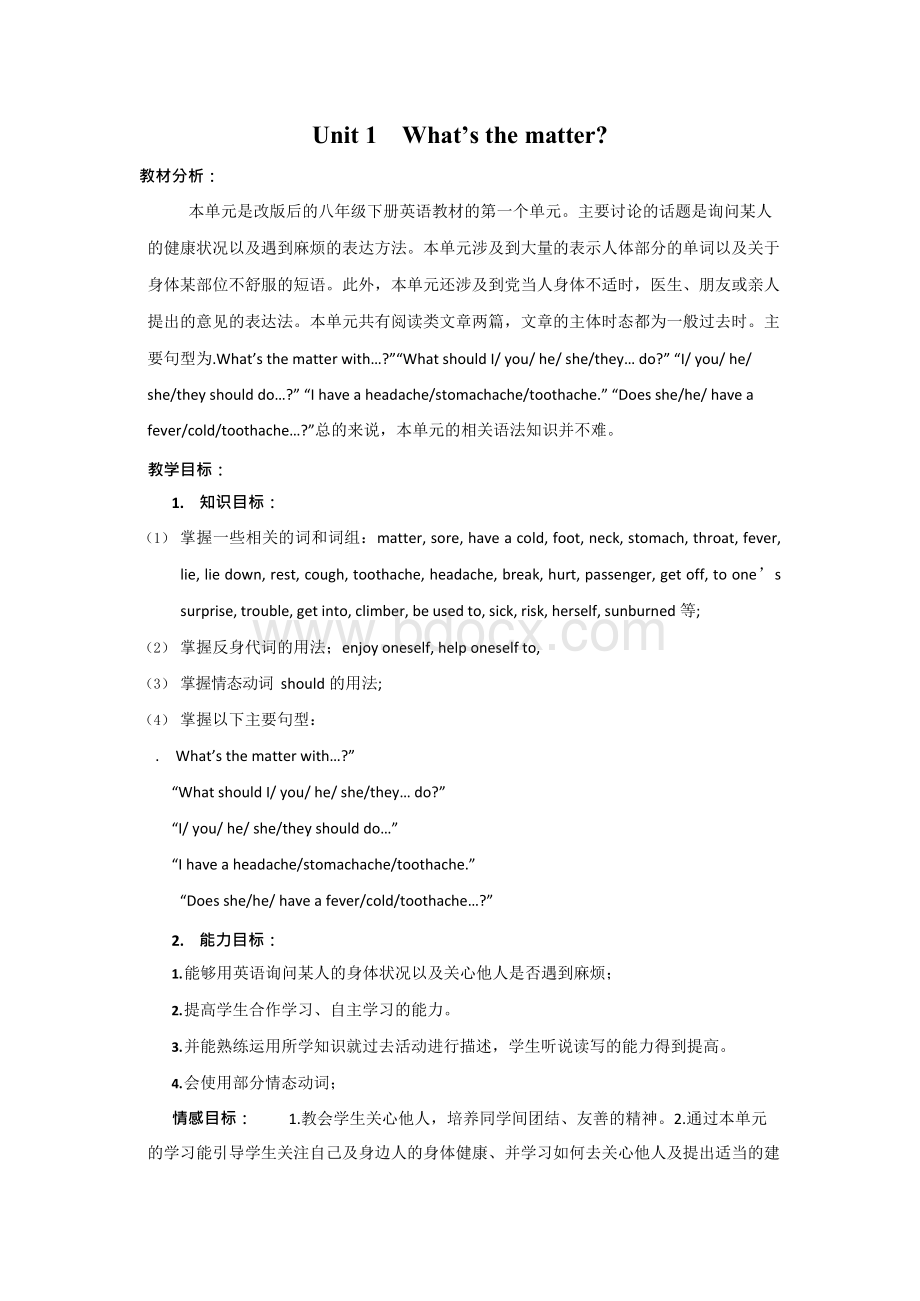英语人教版八年级下册Unit-1-What's-the-matter?单元教案.docx
《英语人教版八年级下册Unit-1-What's-the-matter?单元教案.docx》由会员分享,可在线阅读,更多相关《英语人教版八年级下册Unit-1-What's-the-matter?单元教案.docx(24页珍藏版)》请在冰豆网上搜索。

Unit1 What’sthematter?
教材分析:
本单元是改版后的八年级下册英语教材的第一个单元。
主要讨论的话题是询问某人的健康状况以及遇到麻烦的表达方法。
本单元涉及到大量的表示人体部分的单词以及关于身体某部位不舒服的短语。
此外,本单元还涉及到党当人身体不适时,医生、朋友或亲人提出的意见的表达法。
本单元共有阅读类文章两篇,文章的主体时态都为一般过去时。
主要句型为.What’sthematterwith…?
”“WhatshouldI/you/he/she/they…do?
”“I/you/he/she/theyshoulddo…?
”“Ihaveaheadache/stomachache/toothache.”“Doesshe/he/haveafever/cold/toothache…?
”总的来说,本单元的相关语法知识并不难。
教学目标:
1.知识目标:
(1)掌握一些相关的词和词组:
matter,sore,haveacold,foot,neck,stomach,throat,fever,lie,liedown,rest,cough,toothache,headache,break,hurt,passenger,getoff,toone’ssurprise,trouble,getinto,climber,beusedto,sick,risk,herself,sunburned等;
(2)掌握反身代词的用法;enjoyoneself,helponeselfto,
(3)掌握情态动词should的用法;
(4)掌握以下主要句型:
. What’sthematterwith…?
”
“WhatshouldI/you/he/she/they…do?
”“I/you/he/she/theyshoulddo…”
“Ihaveaheadache/stomachache/toothache.”“Doesshe/he/haveafever/cold/toothache…?
”
2.能力目标:
1.能够用英语询问某人的身体状况以及关心他人是否遇到麻烦;
2.提高学生合作学习、自主学习的能力。
3.并能熟练运用所学知识就过去活动进行描述,学生听说读写的能力得到提高。
4.会使用部分情态动词;
情感目标:
1.教会学生关心他人,培养同学间团结、友善的精神。
2.通过本单元的学习能引导学生关注自己及身边人的身体健康、并学习如何去关心他人及提出适当的建
议。
3.能使学生意识到要如何去保持健康并养成良好的生活习惯。
4.培养学生主动救助处于危险境地的人的精神,在紧急关头,有勇气做出正确的决定。
此外,生活中遇到困境,需要有坚强的意志力去面对一切。
教学难点:
掌握情态动词should\shouldn’t.的用法
学习have的用法
课时划分:
SectionA11a–2dSectionA23a-3c
SectionA3GrammarFocus-4cSectionB11a-2e
SectionB23a-Selfcheck
SectionA1(1a–2d)
Step1Warmingupandnewwords
1.Lookatapictureandlearnthepartsofthebody.
2.Newwordsandphrases.
Step2Presentation
1aLookatthepicture.Writethecorrectletter[a-m]foreachpartofthebody.
arm back ear eye foot
hand head leg mouth
neck nose stomach tooth
Step3Listening
1bListenandlookatthepicture.Thennumberthenames1-5Listentotheconversationsagainandfillintheblanks.
Conversation1
Nurse:
What’sthematter,Sarah?
Girl:
I .
Conversation2
Nurse:
What’sthematter,David?
Boy:
I .
Conversation3
Nurse:
What’sthematter,Ben?
Boy:
I .
Conversation4
Nurse:
What’sthematter,Nancy?
Girl:
I .
Conversation5
Betty:
What’sthematter,Judy?
Ann:
She .
Step4Speaking
1cLookatthepictures.Whatarethestudents’problems?
Makeconversations.
Examples
A:
What’sthematterwithJudy?
B:
Shetalkedtoomuchyesterdayanddidn’tdrinkenoughwater.
Shehasaverysorethroatnow.A:
What’sthematterwithSarah?
B:
Shedidn’ttakecareofherselfontheweekend.Shewasplayingwithherfriendsattheparkyesterday.Thenitgotwindy,butshedidn’tputonherjacket.Nowshehasacold.
Step5Guessinggames
Guesswhathashappenedtothestudentsbyusingtheimportantsentences.
Step6Listening
2aListenandnumberthepictures[1-5]intheorderyouhearthem.2bListenagain.Matchtheproblemswiththeadvice.
Step7Speaking
2cMakeconversationsusingtheinformationin2aand2bA:
What’sthematter?
B:
Myheadfeelsveryhot.A:
Maybeyouhaveafever.B:
WhatshouldIdo?
A:
Youshouldtakeyourtemperature.
Step8Role–play
Imagineyouaretheschooldoctor.Afewstudentshavehealthproblems.Role-playaconversationbetweenthedoctorandthestudents.
2dRole–playtheconversation
Step9Languagepointsandsummary
1.What’sthematter?
这是人们特别是医生和护士询问病人病情时最常用的问句, 意思是“怎么了?
”其后通常与介词with连用。
类似的问句还有:
What’swrong?
怎么啦?
What’swrongwithyou?
你怎么了?
What’syourtrouble?
你怎么了?
What’sthetroublewithyou?
你怎么了?
What’sup?
你怎么了?
2.haveacold伤风,感冒,是固定词组表示身体不适的常用词组还有:
haveabadcold重感冒haveafever 发烧haveaheadache 头痛
haveastomachache 肚子痛,胃痛
haveatoothache 牙痛
Summary
1.牙疼 haveatoothache
2.胃疼 haveastomachache
3.背疼 haveabackache
4.头疼 haveaheadache
5.喉咙疼haveasorethroat
6.发烧 haveafever
7.感冒 haveacold
8.躺下并且休息liedownandrest
9.喝热蜂蜜茶 drinkhotteawithhoney
10.喝大量水 drinklotsofwater
11.看牙医 seeadentist
12.量体温 takeone’stemperature
13.看医生 gotoadoctor
Step10Exercises
根据上下文意思填空。
Mandy:
Lisa,areyouOK?
Lisa:
I aheadacheandIcan’tmovemyneck.What Ido?
ShouldI
mytemperature?
Mandy:
No,itdoesn’tsoundlikeyouhaveafever.What youdoontheweekend?
Lisa:
Iplayedcomputer allweekend.
Mandy:
That’sprobablywhy.Youneedtotakebreaks fromthecomputer.Lisa:
Yeah,IthinkIsatinthe wayfortoolongwithoutmoving.
Mandy:
Ithinkyoushould downandrest.Ifyourheadandneckstillhurttomorrow,thengotoa .
Lisa:
OK.Thanks,Mandy.
翻译下列句子。
1.你怎么了?
我头痛。
2.他怎么了?
他发烧
3.李雷怎么了?
他喉咙痛。
他应该多喝水。
4.如果你的头和脖子明天仍然疼的话,请去看医生。
Homework
Makeupaconversationbetweenadoctorandapatient.
SectionA2(3a–3c)
Step1 Presentation
Lookatthepicture.Discusswhathappenedandthenwhatweshoulddo.Teacher:
Whathappenedinthepic